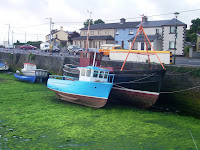The Image gadget
 |
| Dry dock in Claddagh Basin |
This is a tool that Blogger provides to make is easy to add a picture that shows up on all screen and is linked to somewhere.
Often gadgets (sometimes called widgets or page elements) are put on the sidebar - but in many blogger templates they can go in other places too (header, footer, etc).
Follow these steps to add a picture gadget in Blogger
1 Make sure you know where the original picture is and that you have copyright permission to use it.2 Copy the location (URL or file system full path-name) of the picture - and remember whether it's on your computer, or on the internet.
(This article tells you how to find the URL of a picture that's already stored in Google Album Archive. )
3 In Blogger, follow the usual Add a Gadget procedure, and choose the Image gadget from the list of options (you may have to scroll down to find it in the list).
4 In the Configure-Image box, enter the options you want for your picture. These include:
- The title for the Gadget,
- The caption for the picture
(the small words that go underneath it, usually explaining it, or where it came from), - What should happen when a reader clicks the picture - put this into the Link field
- Where to find the picture
(ie the file-location that you copied in step 2) - Whether to re-size (ie shrink) the picture to fix the space in the sidebar in your current template.
5 Press Save.
6 If necessary, drag-and-drop the new gadget to the place where you want the picture to go, and press Save.
What your visitors see
People who visit your blog in a web-browser, will see the picture, in the place where you put the gadget. However pictures are not supported gadgets for dynamic view templates, so it won't be see if you use one of these.
Also, people who see your blog through an RSS reader, or by receiving emailed updates don't see any gadgets, so they will not see the picture.
If you entered a value for Link, your visitor's browser leaves your blog and goes to the Link location: with the Picture gadget, then there is no way to make this open a new window. If you want to do so, then use an HTML gadget instead, get the code for the picture, and put target = "_blank" into it:, so the code looks something like:
Also, people who see your blog through an RSS reader, or by receiving emailed updates don't see any gadgets, so they will not see the picture.
If you entered a value for Link, your visitor's browser leaves your blog and goes to the Link location: with the Picture gadget, then there is no way to make this open a new window. If you want to do so, then use an HTML gadget instead, get the code for the picture, and put target = "_blank" into it:, so the code looks something like:
<a href="YOUR LINK" imageanchor="1" style="margin-left: 1em; margin-right: 1em;" target = "_blank"><img border="0" src="YOUR PICTURE LOCATION" /></a>
Related Articles
Options for putting pictures into your blogCopyright, blogs and bloggers
Picasa and Blogger - an overview
Getting the HTML to add a picture to your blog
Finding a picture's URL in Google Album Archive
Finding the URL of a picture stored in Flickr
Showing a PowerPoint presentation in your blog
Why RSS / Subscribe to Posts is important for bloggers
Following a blog by email





